Supplementing Missing Data Using the Drainage-Area Ratio Method and Evaluating the Streamflow Drought Index with the Corrected Data Set
Abstract
:1. Introduction
2. Materials and Methods
2.1. Study Area and Data Used
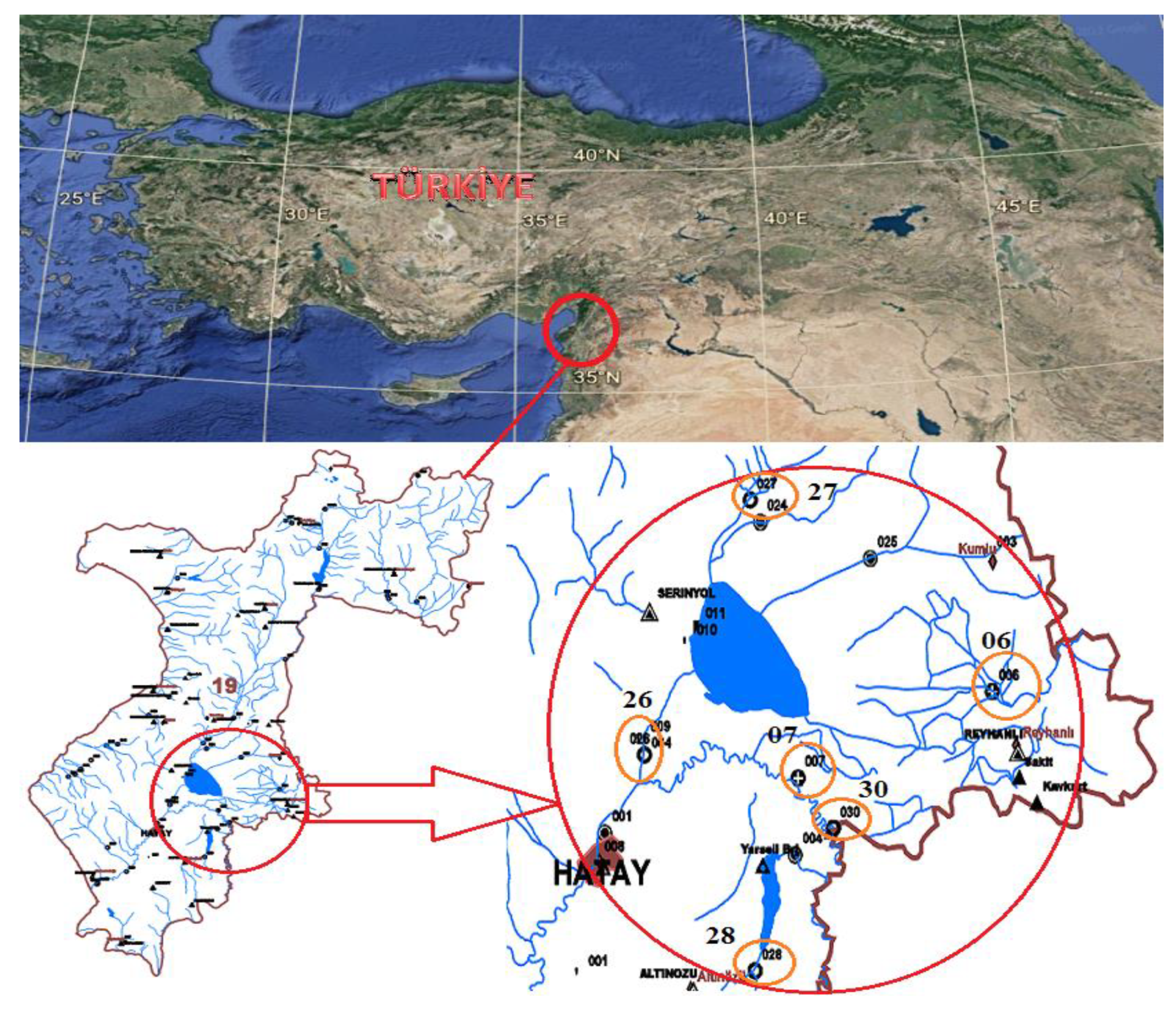
2.2. Drainage-Area Ratio Method
2.3. Streamflow Drought Index Method
3. Results and Discussion
4. Conclusions
Author Contributions
Funding
Institutional Review Board Statement
Informed Consent Statement
Data Availability Statement
Acknowledgments
Conflicts of Interest
References
- Akçakoca, F.; Apaydın, H. Modelling of Bektas Creek daily streamflow with Generalized Regression Neural Network Method. Int. J. Adv. Sci. Res. Eng. 2020, 6, 97–103. [Google Scholar] [CrossRef]
- Mesta, B.; Akgun, O.B.; Kentel, E. Alternative solutions for long missing streamflow data for sustainable water resources management. Int. J. Water Resour. Dev. 2021, 37, 882–905. [Google Scholar] [CrossRef]
- Asaad, M.N.; Eryürük, Ş.; Eryürük, K. Forecasting of streamflow and comparison of artificial intelligence methods: A case study for Meram Stream in Konya, Turkey. Sustainability 2022, 14, 6319. [Google Scholar] [CrossRef]
- Turhan, E.; Özmen-Çağatay, H. Using of Artificial Neural Network (ANN) for setting estimation model of missing flow data: Asi River-Demirköprü Flow Observation Station (FOS). Çukurova Üniversitesi Mühendislik Mimar. Fakültesi Derg. 2016, 31, 93–106. [Google Scholar] [CrossRef] [Green Version]
- Loganathan, P.; Mahindrakar, A.B. Intercomparing the robustness of machine learning models in simulation and forecasting of streamflow. J. Water Clim. Chang. 2021, 12, 1824–1837. [Google Scholar] [CrossRef]
- Kilinc, H.C. Daily streamflow forecasting based on the hybrid Particle Swarm Optimization and Long Short-Term Memory model in the Orontes Basin. Water 2022, 14, 490. [Google Scholar] [CrossRef]
- Üneş, F.; Demirci, M.; Zelenakova, M.; Çalışıcı, M.; Taşar, B.; Vranay, F.; Kaya, Y.Z. River Flow Estimation Using Artificial Intelligence and Fuzzy Techniques. Water 2020, 12, 2427. [Google Scholar] [CrossRef]
- Yilmaz, M.; Tosunoğlu, F.; Kaplan, N.H.; Üneş, F.; Hanay, Y.S. Predicting monthly streamflow using artificial neural networks and wavelet neural networks models. Model. Earth Syst. Environ. 2022, 8, 5547–5563. [Google Scholar] [CrossRef]
- Mehraein, M.; Mohanavelu, A.; Naganna, S.R.; Kulls, C.; Kisi, O. Monthly Streamflow Prediction by Metaheuristic Regression Approaches Considering Satellite Precipitation Data. Water 2022, 14, 3636. [Google Scholar] [CrossRef]
- Hamzah, F.B.; Hamzah, F.M.; Razali, S.F.M.; Jaafar, O.; Jamil, N.A. Imputation methods for recovering streamflowobservation: A methodological review. Cogent Environ. Sci. 2020, 6, 1745133. [Google Scholar] [CrossRef]
- Ergen, K.; Kentel, E. An integrated map correlation method and multiple-source sites drainage-area ratio method for estimating streamflows at ungauged catchments: A case study of Western Black Sea Region, Turkey. J. Environ. Manag. 2016, 166, 309–320. [Google Scholar] [CrossRef] [PubMed]
- Li, Q.; Peng, Y.; Wang, G.; Wang, H.; Xue, B.; Hu, X. A Combined Method for Estimating Continuous Runoff by Parameter Transfer and Drainage Area Ratio Method in Ungauged Catchments. Water 2019, 11, 1104. [Google Scholar] [CrossRef] [Green Version]
- Saka, F.; Babacan, H.T. Discharge Estimation by Drainage Area Ratio Method at Some Specific Discharges for 2251 Stream Gauging Station in East Black Sea Basin, Turkey. J. Investig. Eng. Technol. 2019, 2, 309–320. [Google Scholar]
- Yılmaz, M.U.; Önöz, B. Evaluation of statistical methods for estimating missing daily streamflow data. Tek. Dergi 2019, 30, 9597–9620. [Google Scholar] [CrossRef] [Green Version]
- Yılmaz, M.U.; Önöz, B. A comparative study of statistical methods for daily streamflow estimation at ungauged basins in Turkey. Water 2020, 12, 459. [Google Scholar] [CrossRef] [Green Version]
- Bakış, R.; Şirin, F.Ç.; Bayazıt, Y. Linear Analysis of Region-Ratio Method for Flow Gauges. İklim Değişikliği Ve Çevre Derg. 2020, 5, 8–15. [Google Scholar]
- Değerli, S.; Turhan, E. Investigation of Streamflow Data Accuracy with Bias Correction Using Drainage Area-Ratio Method. Eur. J. Sci. Technol. 2022, 34, 100–104. [Google Scholar] [CrossRef]
- Turhan, E.; Değerli, S. A Comparative Study of Probability Distribution Models for Flood Discharge Estimation: Case of Kravga Bridge, Turkey. Cas. Geofiz. J. 2022, 39, 243–257. [Google Scholar] [CrossRef]
- Turhan, E. An Investigation on the Effect of Outliers for Flood Frequency Analysis: The Case of the Eastern Mediterranean Basin, Turkey. Sustainability 2022, 14, 16558. [Google Scholar] [CrossRef]
- Djamel, B.; Houari, Z.; Fares, B. Floods and Hydrograms of Floods of Rivers in Arid Zones of the Mediterranean, Case of the Kingdom of Morocco. Int. J. Geosci. 2020, 11, 651–666. [Google Scholar] [CrossRef]
- Gümüş, V. Hydrological drought analysis of Asi River Basin with Streamflow Drought Index. GU J. Sci. Part C 2017, 5, 65–73. [Google Scholar]
- Dikici, M. Drought analysis with different indices for the Asi Basin (Turkey). Sci. Rep. 2020, 10, 20739. [Google Scholar] [CrossRef] [PubMed]
- Turhan, E.; Çulha, B.D.; Değerli, S. Hydrological evaluation of Streamflow Drought Index method for different time scales: A case study of Arsuz Plain, Turkey. J. Nat. Hazards Environ. 2022, 8, 25–36. [Google Scholar] [CrossRef]
- Turhan, E.; Değerli, S.; Çatal, E.N. Long-term hydrological drought analysis in agricultural irrigation area: The case of Dörtyol-Erzin Plain, Turkey. Curr. Trends Nat. Sci. 2022, 21, 501–512. [Google Scholar] [CrossRef]
- Topçu, E.; Seçkin, N.; Haktanır, N.E. Drought analyses of Eastern Mediterranean, Seyhan, Ceyhan, and Asi Basins by using aggregate drought index (ADI). Theor. Appl. Climatol. 2022, 147, 909–924. [Google Scholar] [CrossRef]
- Nalbantis, I.; Tsakiris, G. Evaluation of a Hydrological Drought Index. Eur. Water 2008, 23, 67–77. [Google Scholar] [CrossRef]
- Abbas, A.; Waseem, M.; Ullah, W.; Zhao, C.; Zhu, J. Spatiotemporal analysis of meteorological and hydrological droughts and their propagations. Water 2021, 13, 2237. [Google Scholar] [CrossRef]
- Kubiak-Wójcicka, K.; Nagy, P.; Zelenáková, M.; Hlavatá, H.; Abd-Elhamid, H.F. Identification of Extreme Weather Events Using Meteorological and Hydrological Indicators in the Laborec River Catchment, Slovakia. Water 2021, 13, 1413. [Google Scholar] [CrossRef]
- Katipoğlu, O.M.; Acar, R.; Şenocak, S. Spatio-temporal analysis of meteorological and hydrological droughts in the Euphrates Basin, Turkey. Water Supply 2021, 21, 1657–1673. [Google Scholar] [CrossRef]
- Zhang, Q.; Miao, C.; Gou, J.; Wu, J.; Jiao, W.; Song, Y.; Xu, D. Spatiotemporal characteristics of meteorological to hydrological drought propagation under natural conditions in China. Weather. Clim. Extrem. 2022, 38, 100505. [Google Scholar] [CrossRef]
- The State Hydraulic Works (knownly as DSI). Annual Streamflow Observation Records (1986–2020). Head of Study and Planning Department, Ankara. 2015. Available online: https://www.dsi.gov.tr/Sayfa/Detay/744 (accessed on 15 September 2022).
- Nalcıoğlu, A.; Ünsal, M.; Ercan, B.; Yağcı, A.E. Modeling of hydrometeorological factors with discharge in Asi Basin. KSU J. Agric. Nat. 2020, 23, 1510–1517. [Google Scholar] [CrossRef]
- Geçen, R.; Usun, Ç.F. Orontes River, it’s basin, international usage and problems. Elazığ, Türkiye. Int. Symp. Geomorphol. 2017, 636–644. Available online: http://www.ujes.org/anasayfa/ (accessed on 15 September 2022).
- Emerson, D.G.; Vecchia, A.V.; Dahl, A.L.; United States Geological Survey (USGS); Bureau of Reclamation. Evaluation of Drainage-Area Ratio Method Used to Estimate Streamflow for the Red River of the North Basin, North Dakota and Minnesota; US Department of the Interior: Washington, DC, USA; US Geological Survey: Reston, VA, USA, 2005.
- Fung, K.F.; Huang, Y.F.; Koo, C.H.; Tan, K.W. Standardized Precipation Index (SPI) and Standardized Precipation Evapotranspiration Index (SPEI) drought characteristic and trend analysis using the second generation canadian earth system model (CanESM2) outputs under representative concentration pathway (RCP) 8.5. Carpathian J. Earth Environ. Sci. 2019, 14, 399–408. [Google Scholar] [CrossRef]
- Safarianzengir, V.; Sobhani, B. Simulation and analysis of natural hazard phenomenon, drought in Southwest of The Caspian Sea, Iran. Carpathian J. Earth Environ. Sci. 2020, 15, 127–136. [Google Scholar] [CrossRef]
- Moccia, B.; Mineo, C.; Ridolfi, E.; Russo, F.; Napolitano, F. SPI-Based Drought Classification in Italy: Influence of Different Probability Distribution Functions. Water 2022, 14, 3668. [Google Scholar] [CrossRef]
- Norliyana, W.; Ismail, W.; Zawiah, W.; Zin, W.; Ibrahim, W. Estimation of rainfall and streamflow missing data for Terengganu, Malaysia by using interpolation technique methods. Malays. J. Fundam. Appl. Sci. 2017, 13, 213–217. [Google Scholar] [CrossRef]
- Turhan, E.; Kaya Keleş, M.; Tantekin, A.; Keleş, A.E. The Investigation of the Applicability of Data-Driven Techniques in Hydrological Modeling: The Case of Seyhan Basin. Rocz. Ochr. Sr. 2019, 21, 29–51. [Google Scholar]
- Salimi, H.; Asadi, E.; Darbandi, S. Meteorological and Hydrological Drought Monitoring Using Several Drought Indices. Appl. Water Sci. 2021, 11, 11. [Google Scholar] [CrossRef]
- Cammalleri, C.; Vogt, J.; Salamon, P. Development of an operational low-flow index for hydrological drought monitoring over Europe. Hydrol. Sci. J. 2017, 62, 346–358. [Google Scholar] [CrossRef]
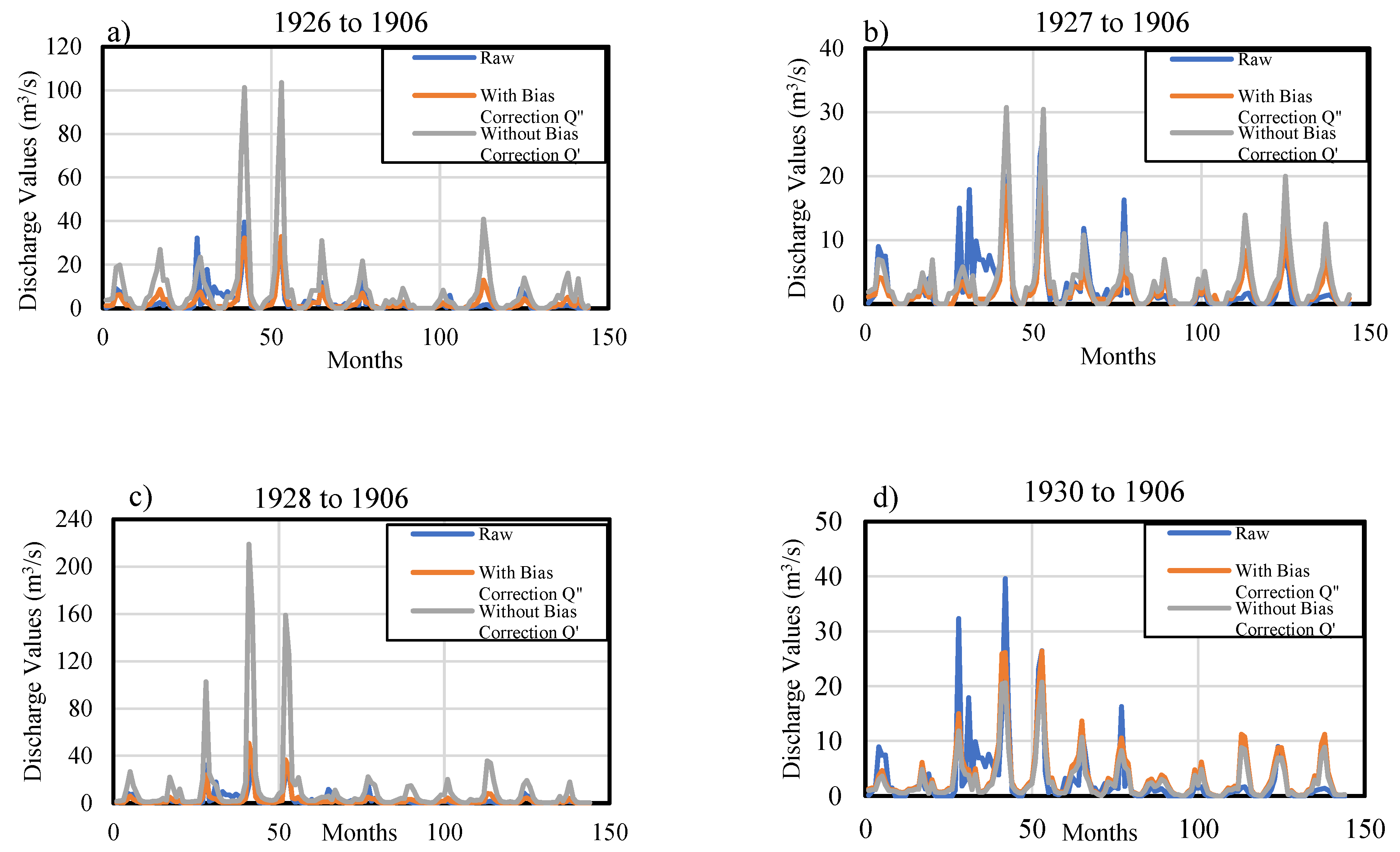


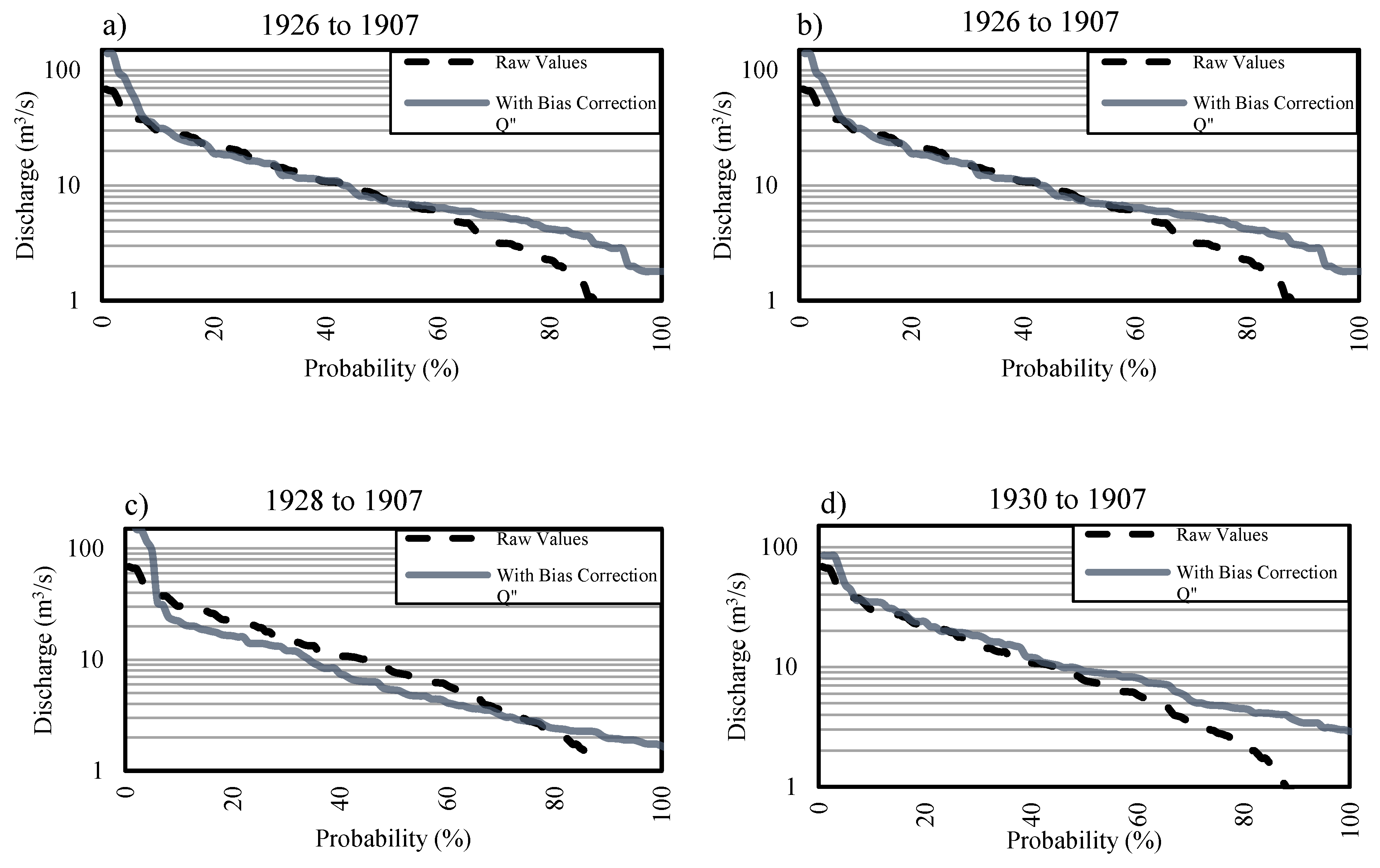


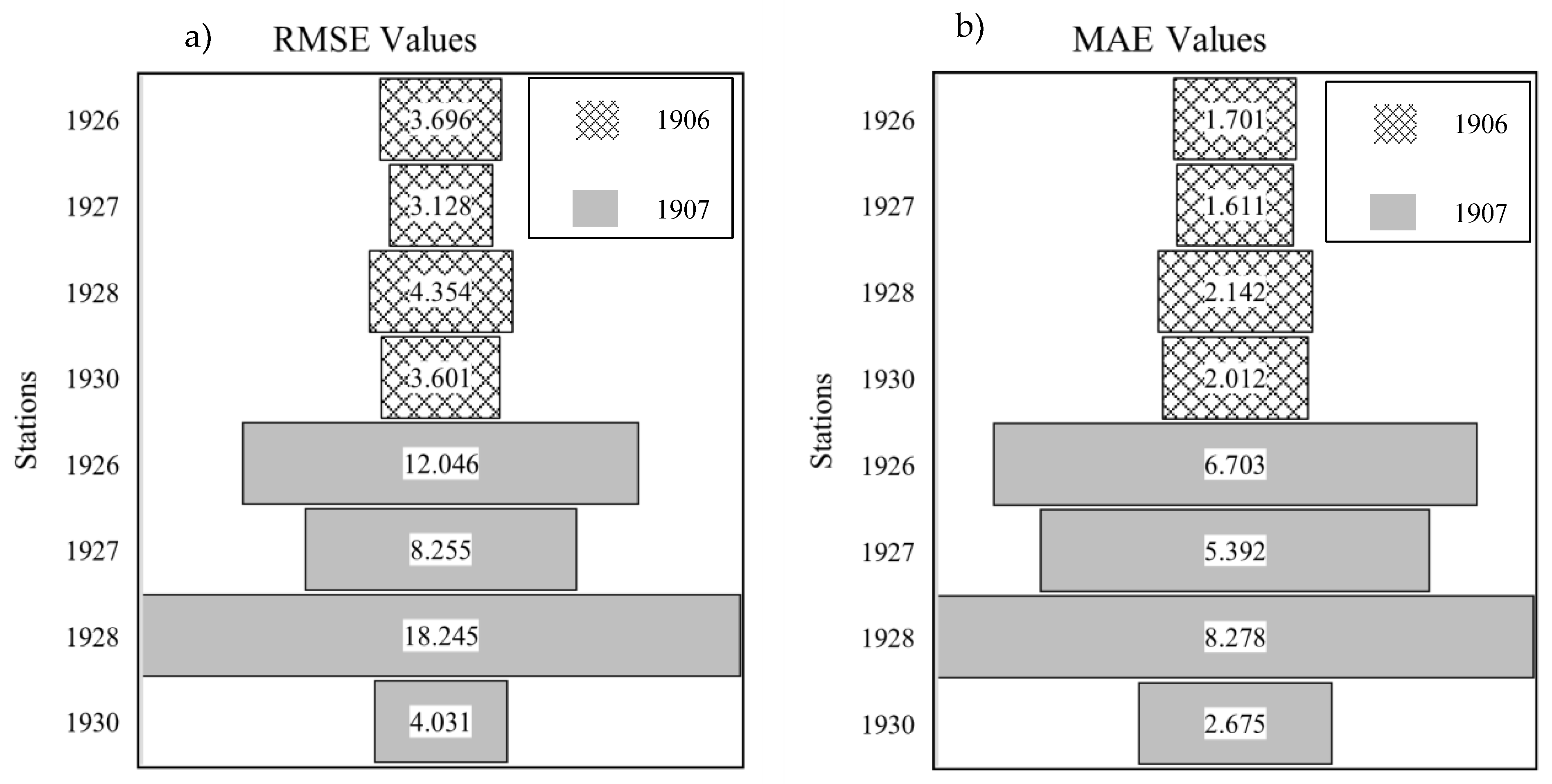
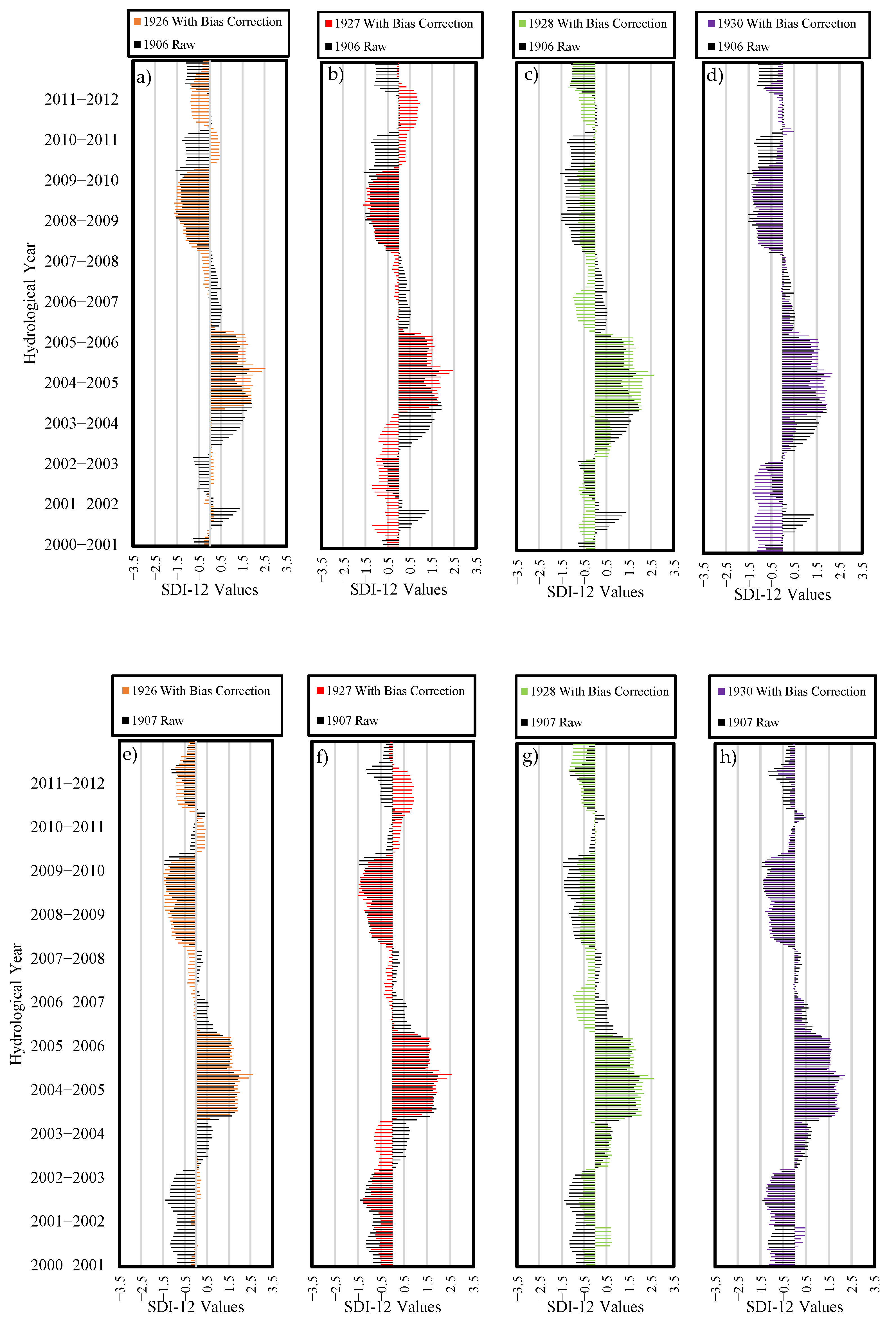
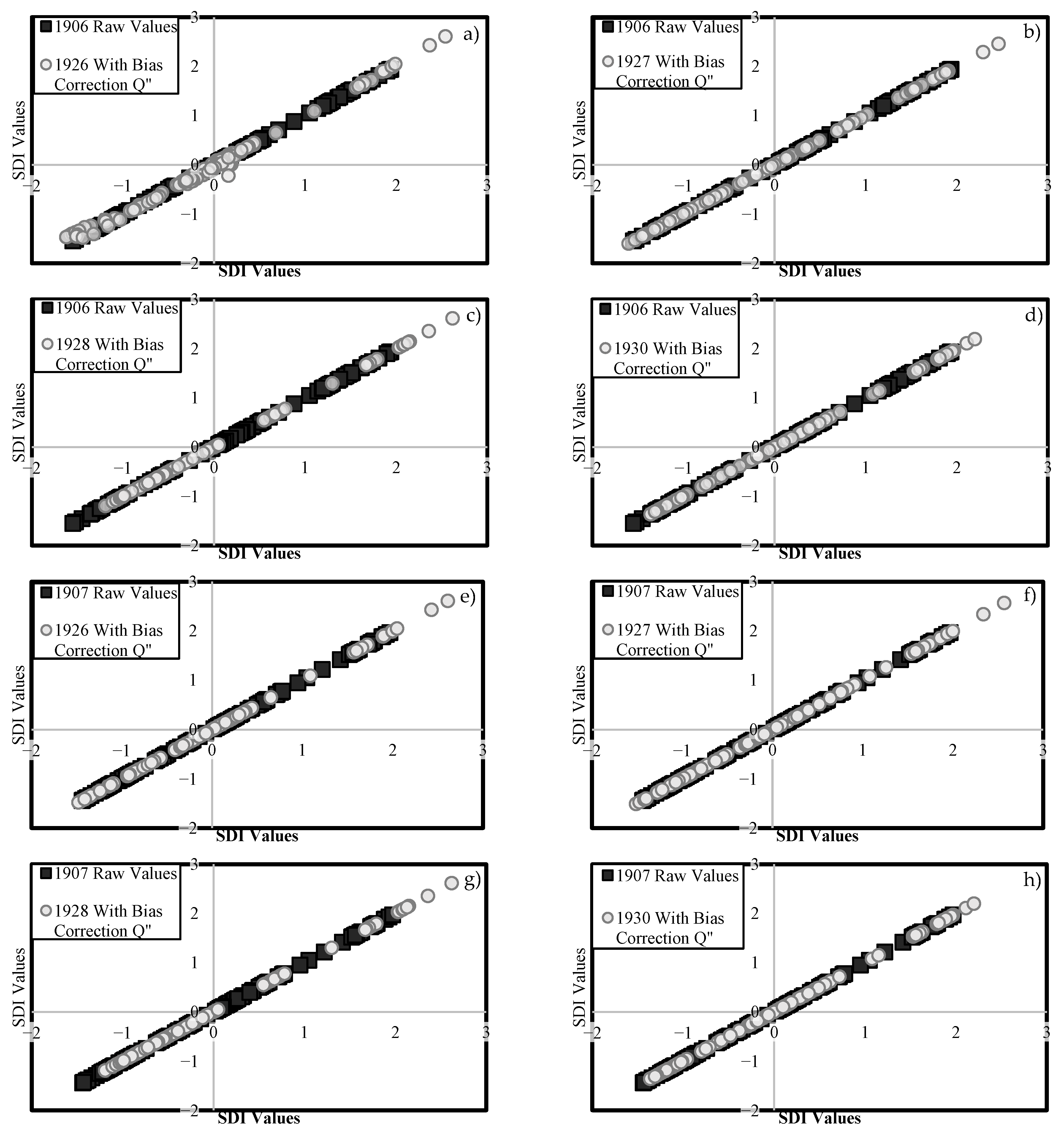
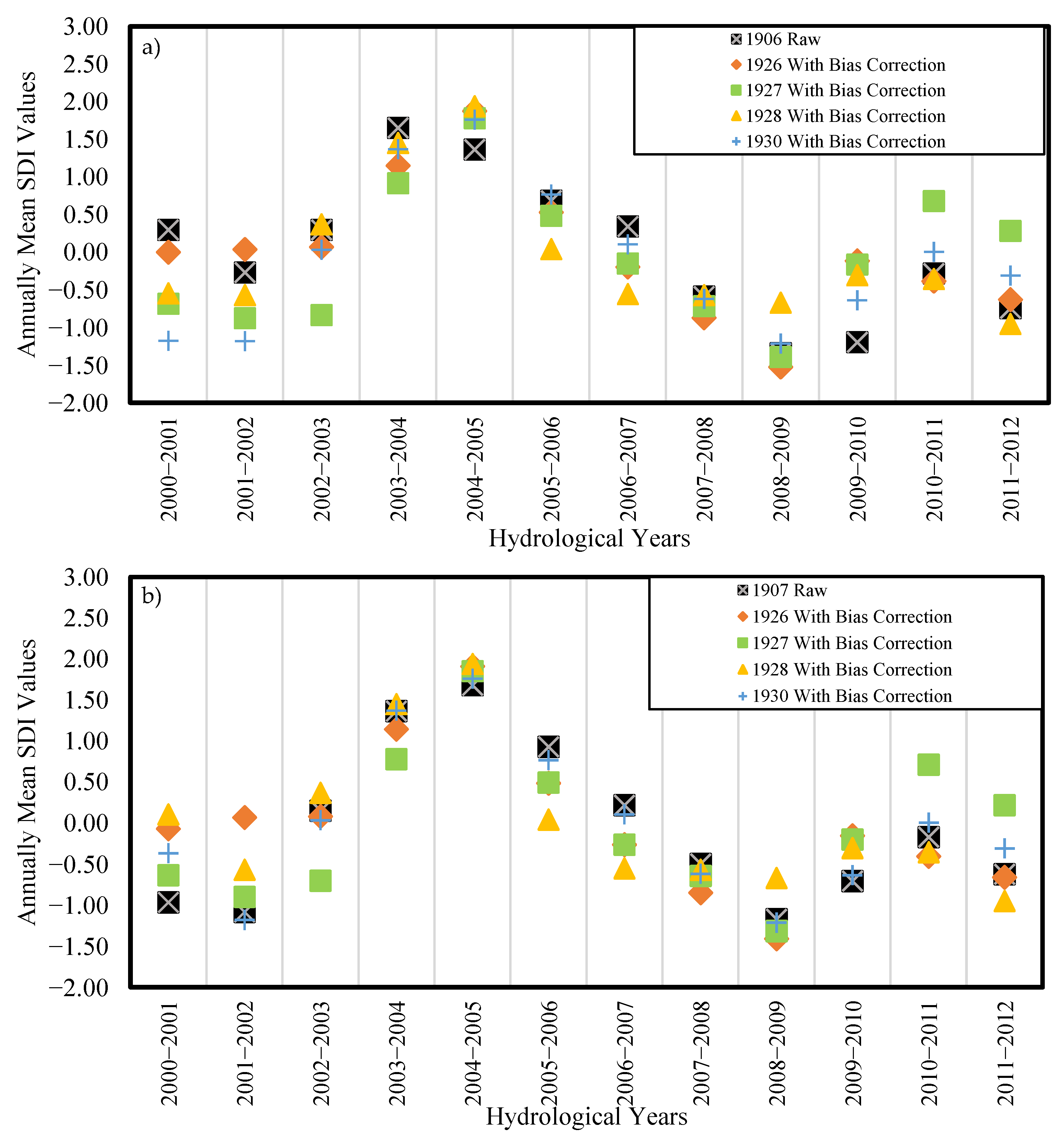
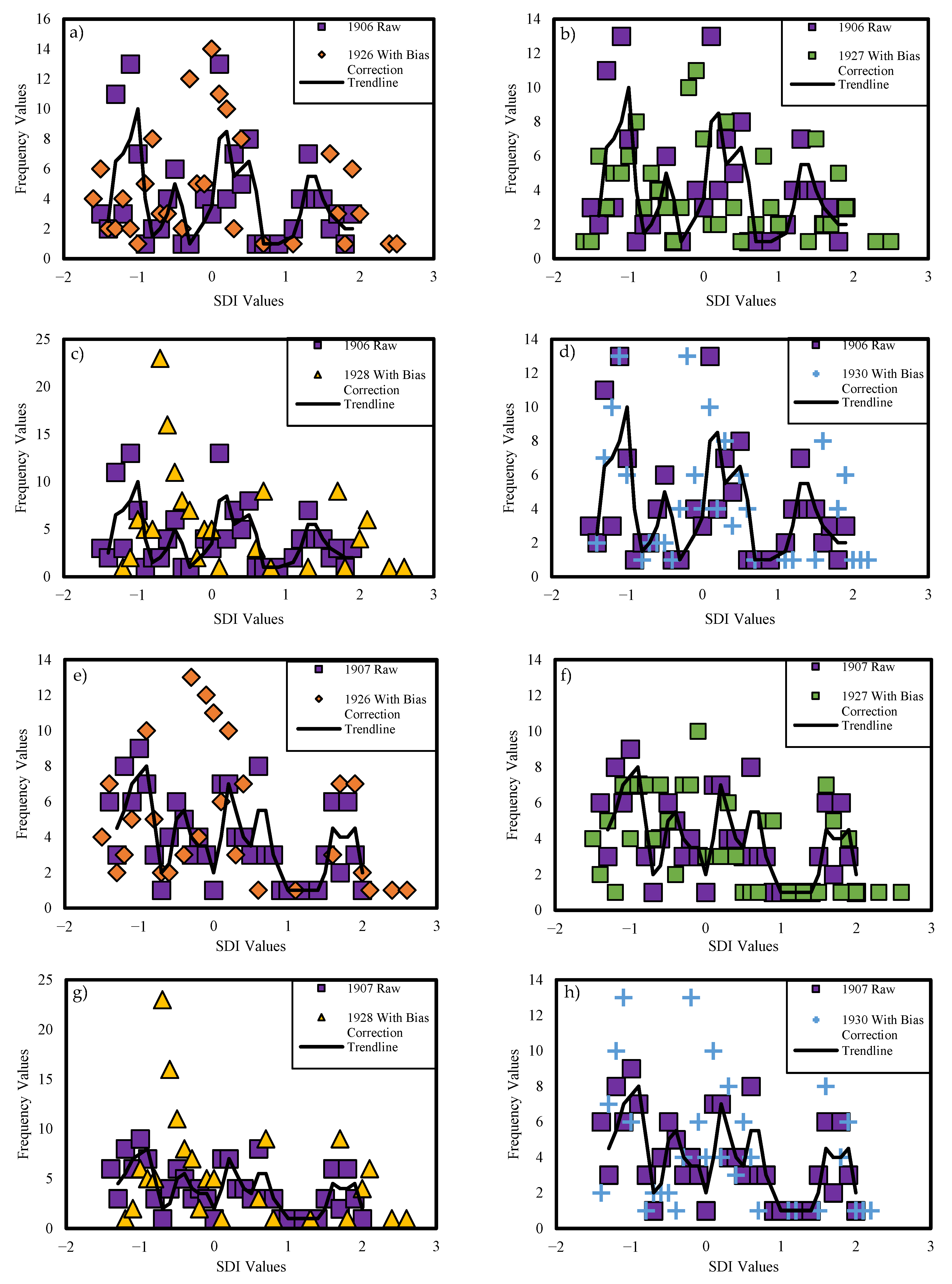
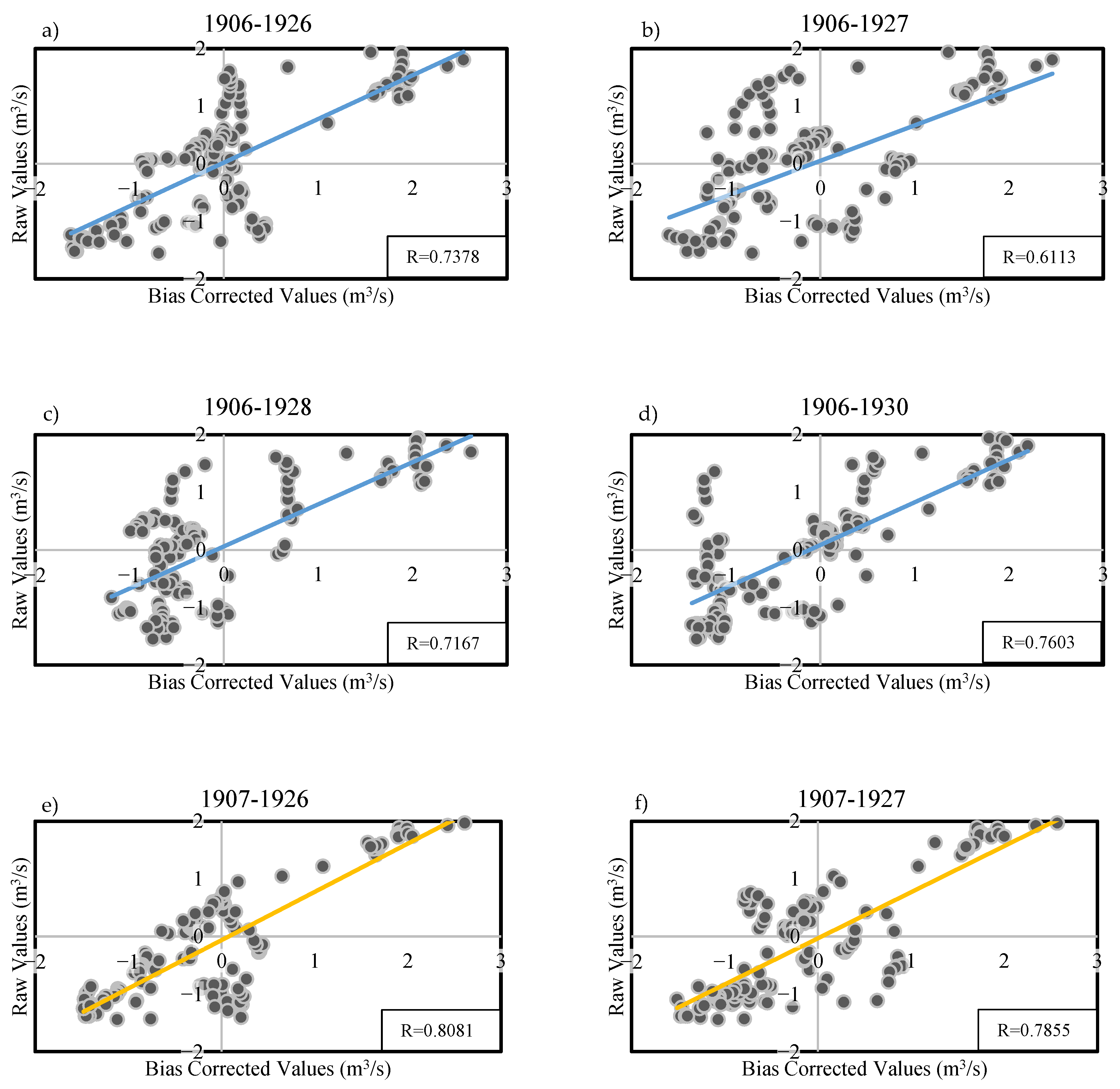

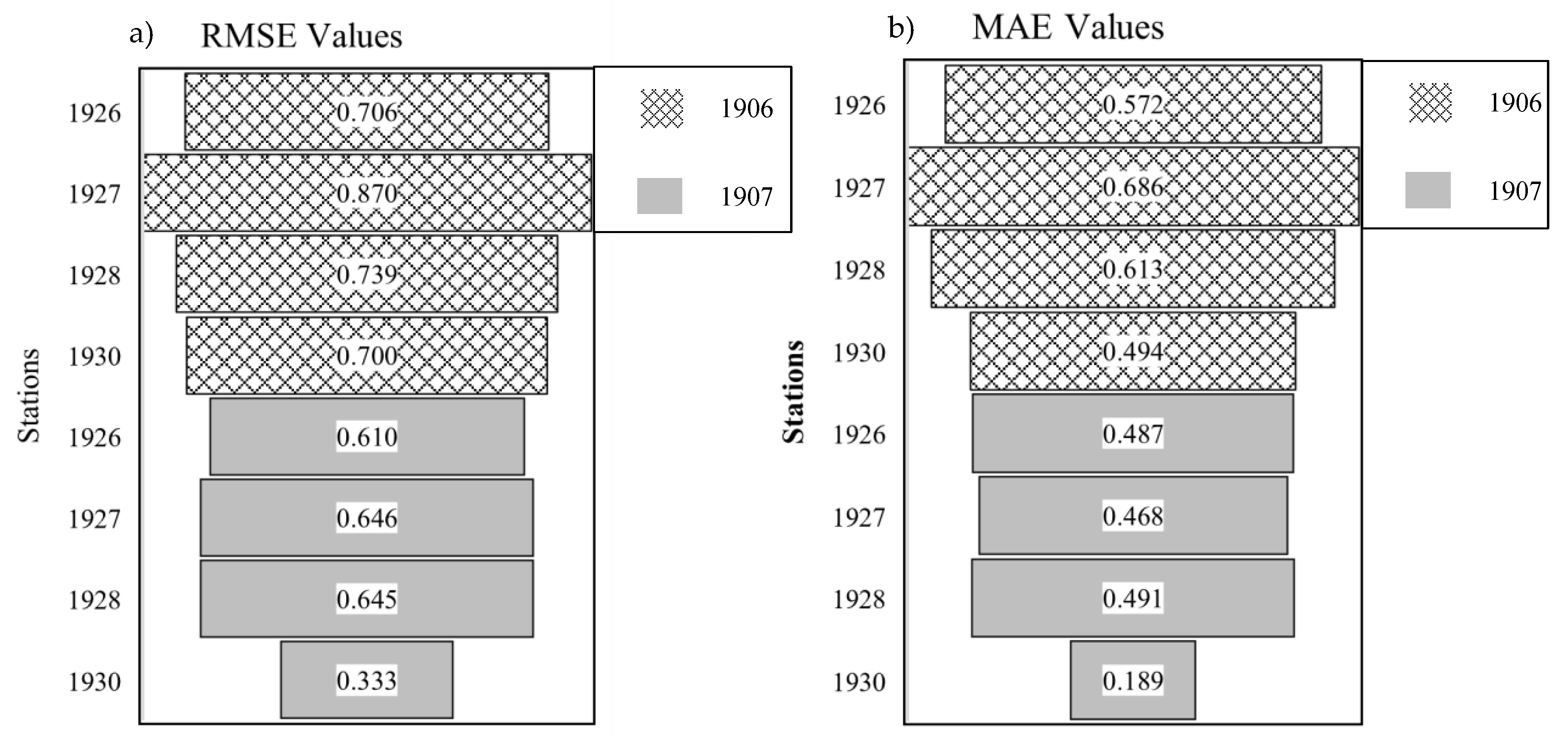
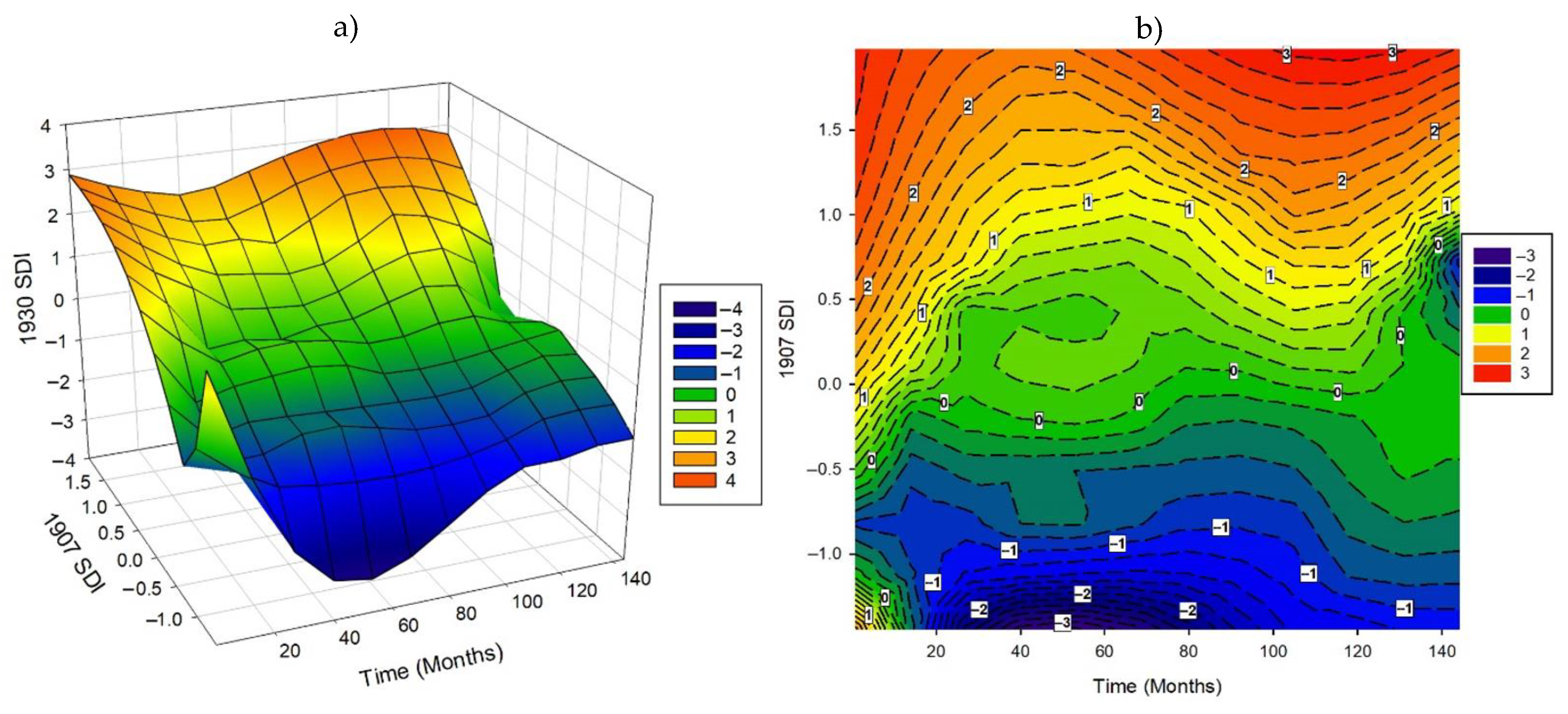
| Station No. | Latitude (N) | Longitude (E) | Drainage Area (km2) |
|---|---|---|---|
| D19A026 (1926) | 36°57′03″ | 33°02′11″ | 2689.2 |
| D19A027 (1927) | 36°39′34″ | 34°00′02″ | 1005.2 |
| D19A028 (1928) | 36°10′32″ | 32°23′44″ | 313.2 |
| D19A030 (1930) | 36°10′32″ | 32°23′44″ | 313.2 |
| 1906 | 36°10′32″ | 32°23′44″ | 313.2 |
| 1907 | 36°10′32″ | 32°23′44″ | 313.2 |
| Index Value | Category |
|---|---|
| SDI ≤ −2 | Extreme drought |
| −2 < SDI ≤ −1.5 | Severe drought |
| −1.5 < SDI ≤ −1 | Moderate drought |
| −1 < SDI ≤ 0 | Mild drought |
| 0 < SDI ≤ 1 | Mildly wet |
| 1 < SDI ≤ 1.5 | Moderately wet |
| 1.5 < SDI ≤ 2 | Severely wet |
| SDI > 2 | Extremely wet |
Disclaimer/Publisher’s Note: The statements, opinions and data contained in all publications are solely those of the individual author(s) and contributor(s) and not of MDPI and/or the editor(s). MDPI and/or the editor(s) disclaim responsibility for any injury to people or property resulting from any ideas, methods, instructions or products referred to in the content. |
© 2023 by the authors. Licensee MDPI, Basel, Switzerland. This article is an open access article distributed under the terms and conditions of the Creative Commons Attribution (CC BY) license (https://creativecommons.org/licenses/by/4.0/).
Share and Cite
Turhan, E.; Değerli Şimşek, S. Supplementing Missing Data Using the Drainage-Area Ratio Method and Evaluating the Streamflow Drought Index with the Corrected Data Set. Water 2023, 15, 425. https://doi.org/10.3390/w15030425
Turhan E, Değerli Şimşek S. Supplementing Missing Data Using the Drainage-Area Ratio Method and Evaluating the Streamflow Drought Index with the Corrected Data Set. Water. 2023; 15(3):425. https://doi.org/10.3390/w15030425
Chicago/Turabian StyleTurhan, Evren, and Serin Değerli Şimşek. 2023. "Supplementing Missing Data Using the Drainage-Area Ratio Method and Evaluating the Streamflow Drought Index with the Corrected Data Set" Water 15, no. 3: 425. https://doi.org/10.3390/w15030425





